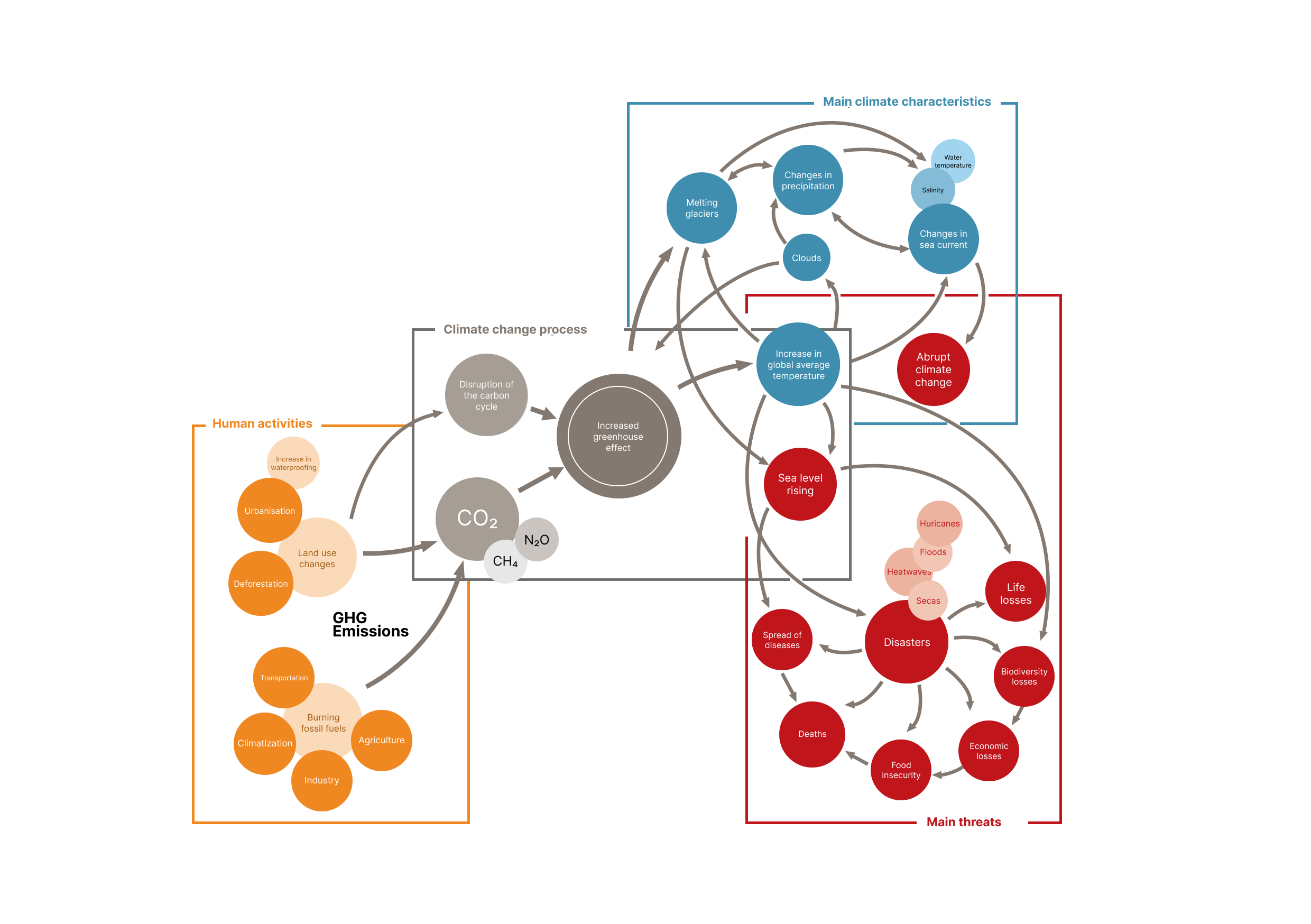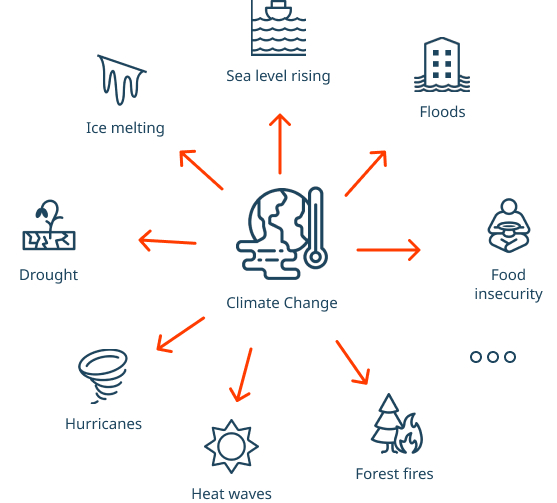Climate change is a complex phenomenon caused by an increase in greenhouse gases (GHG) in the atmosphere. These gases can originate from natural phenomena or industrial processes.
The former include carbon dioxide (CO2), methane (CH4) and nitrogen (N2O). Fluorinated gases such as hydrofluorocarbons (HFCs), sulphur hexafluoride (SF6) and nitrogen trifluoride (NF2) are synthetic. GHGs trap heat from the sun in the Earth’s atmosphere, thus warming the planet’s surface.
The greenhouse effect is natural and essential for keeping the Earth’s temperature within a range that makes it habitable, but human activities – – particularly the burning of fossil fuels, deforestation and industrial processes – have significantly increased the concentration of these gases. This worsening of the greenhouse effect is causing the average temperature of the atmosphere to rise, leading to the phenomenon we call global warming.
The Earth’s climate is undergoing rapid changes compared to historical natural variations. This is evident from various observations, such as the increase in average global temperatures, the rise in average sea levels, changes in terrestrial and aquatic ecosystems, or changes in ice cover.
O aquecimento global leva a alterações nas principais variáveis climáticas – temperatura (do ar, do oceano de outras massas de água), precipitação, vento e circulação das correntes oceânicas, originando o que se designa por mudanças climáticas.
Estas mudanças – associadas à subida do nível do mar, resultante tanto do degelo e de calotes polares como da expansão térmica da água –, são por sua vez responsáveis por eventos climáticos extremos como secas, cheias, ondas de calor e tempestades de vento ou furacões. Estes eventos potenciam ameaças ao estilo de vida tradicional, como a perda de biodiversidade, perdas económicas, insegurança alimentar, proliferação de doenças e até a perda de vidas humanas.

Regarding extreme phenomena, the occurrence of increasingly prolonged droughts and episodes of precipitation that are more concentrated in space and time are expected to occur, leading to more floods. As impacts of climate change, we can see a greater spread of diseases in humans, animals and plants, a change in agricultural productivity, an increase in damage to infrastructure and buildings, or the migration of people and animals, for example.
Global warming has consequences at a local level: Cabo Verde is already hotter. And the impact of climate change is already being felt in the country. It is expected that, by the end of this century, the temperature may increase. And, in terms of changes in precipitation, most scenarios point to a reduction.

Deforestation and changes in land use also contribute to reducing the Earth’s capacity to absorb CO2. Added to this are agricultural practices such as farming and the use of synthetic fertilisers, which release methane and nitrogen, GHGs that are even more harmful than CO2 because they retain more heat per molecule. The accumulation of these GHGs leads to an increase in global temperatures, changes in weather patterns and a series of adverse environmental effects.

Increasingly frequent and serious extreme phenomena, such as hurricanes, droughts and forest fires, are causing major environmental and socio-economic damage and loss of human life.
In addition, climate change is exacerbating existing problems such as food insecurity, water scarcity and the spread of vector-borne diseases (such as parasites, bacteria or viruses), posing a significant threat to human well-being.

The first contributes to a transition to renewable and clean energy sources, such as wind, solar and hydroelectric power. Improving energy efficiency in transport, industry and buildings also plays a vital role in reducing the carbon footprint. Ocean conservation, reforestation and sustainable land use practices can help sequester carbon. In addition, individuals can make a difference by adopting sustainable lifestyles, reducing waste generated and advocating climate-conscious policies.
The second approach – adaptation – although necessary in all geographical contexts, is a priority for countries whose emissions are low-intensity but the impacts of climate change are widely felt. The most advantageous adaptation options are those that are likely to generate socio-economic benefits. One of the ways to protect our environment from climate change is to resort to what are known as nature-based solutions.
Addressing climate change requires a societal effort at all levels to reduce emissions, increase resilience and make the just transition to a sustainable future.
Despite its low GHG emissions, Cabo Verde is one of the countries most vulnerable to climate change.
Like other Small Island Developing States (SIDS), it contributes little to global warming. But due to the fragility of its ecosystems, it is among the countries suffering the most from the consequences, with an increase in climate aridity and the frequency of droughts, worsening saltwater intrusion and deterioration of groundwater, soil degradation and loss of biodiversity, and an increase in the frequency of storms and hurricanes, among others.
Cabo Verde is a small emitter: emits, per capita, 1.42 tonnes of CO2eq compared to the current average of 3.39 tonnes of CO2eq for African countries and 6.9 tonnes of CO2eq for the average country in the world.
(Jones et al. (2023) in “Our World in Data”)
However, this archipelago of ten volcanic islands with no permanent watercourses, no natural forests, limited mineral resources and a shortage of areas suitable for agriculture (only 12 per cent of its territory is arable land) is exposed to increasingly extreme climatic events such as droughts, floods, heatwaves and windstorms or hurricanes, which pose threats to the traditional way of life, such as loss of biodiversity, economic losses, food insecurity, proliferation of diseases and even loss of human life.
Cabo Verde is an extremely vulnerable country to the impacts of climate change. This is recognised at both national and international level, and is reflected in the priority given to the need to increase climate resilience, both by strengthening climate governance and by greater and better implementation of adaptation measures at local level.
This is already reflected in the Plano Estratégico de Desenvolvimento Sustentável 2022-2026 – PEDS II (Strategic Plan for Sustainable Development 2022-2026 – PEDS II), which includes a climate action pillar. Furthermore, Cabo Verde has two main specific climate policy instruments that establish consolidated climate governance, with a vision of a more resilient country: the updated Nationally Determined Contribution (NDC) (March 2021) and the National Adaptation Plan (NAP) (October 2022).
The NDC reflects Cabo Verde’s commitment to tackle climate change by 2030 under the 2015 Paris Agreement, and recognises the country’s main vulnerabilities:

It is defined, in human systems, as the process of adaptation to actual or expected…
Read more

Natural deposits – forests, oceans and soils – that absorb and capture carbon dioxide (CO2)…
Read more

Climate action refers to efforts made to combat climate change and its impacts. These efforts…
Read more

Lorem ipsum dolor sit amet, consectetur adipiscing elit. Ut elit tellus, luctus nec ullamcorper mattis, pulvinar dapibus.

Lorem ipsum dolor sit amet, consectetur adipiscing elit. Ut elit tellus, luctus nec ullamcorper mattis, pulvinar dapibus.